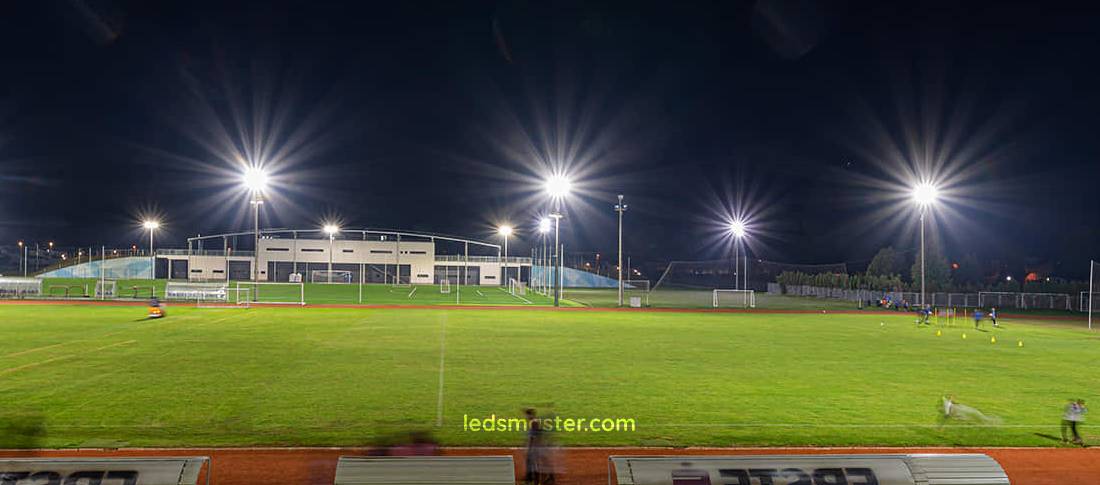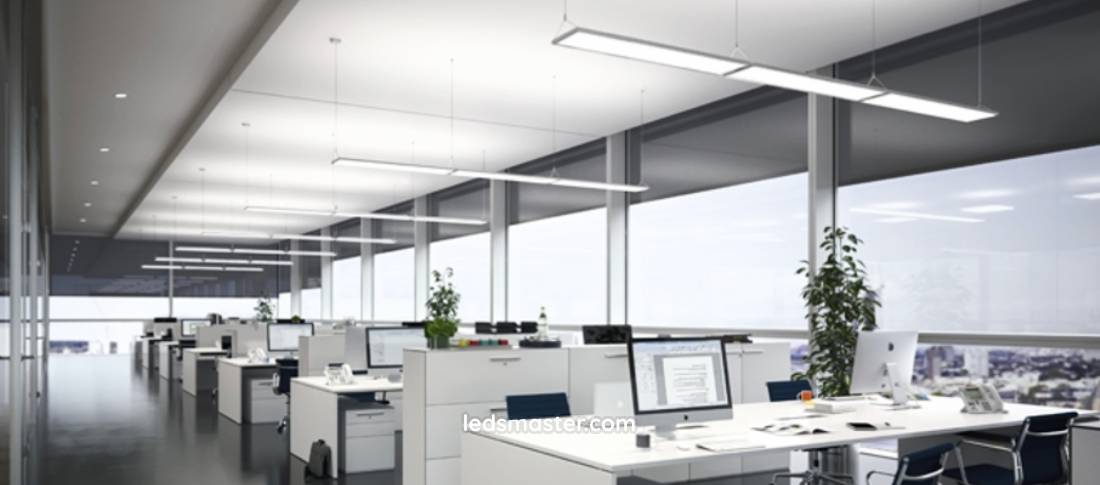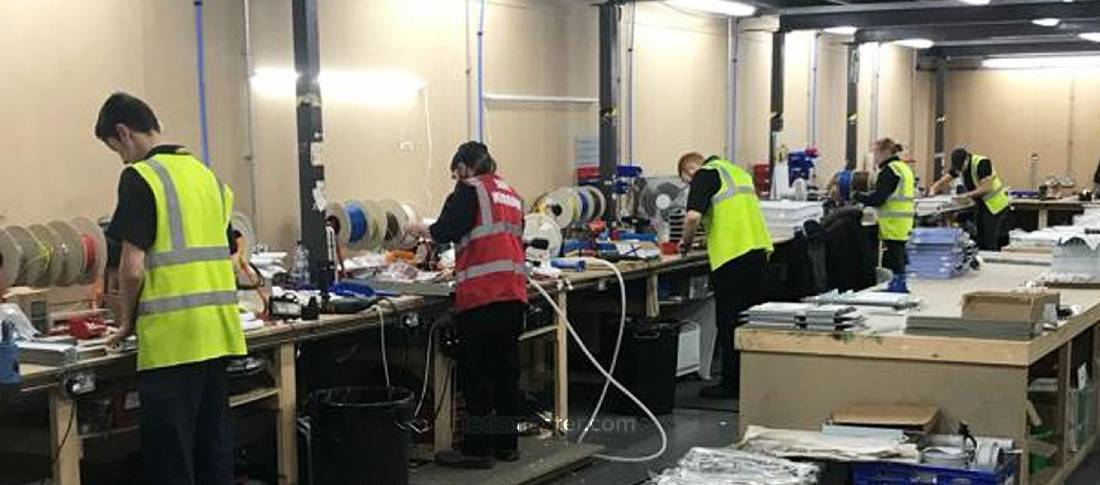Table of Contents
ToggleApplications of Addressable Lighting in Various Sectors
Addressable lighting has extensive applications across a broad range of sectors, where it not only enhances the quality of illumination but also significantly boosts the efficiency and adaptability of lighting systems. This advanced technology allows for granular control over individual lighting fixtures, enabling users to adjust brightness, color, and timing with unprecedented precision. Such fine-tuned control is invaluable in meeting the specific needs of different environments, making it possible to create customized lighting scenarios that are impossible to achieve with traditional, fixed lighting setups. Whether in large-scale industrial facilities, bustling commercial spaces, or specialized environments like sports arenas, addressable lighting systems offer tailored solutions that maximize both functionality and energy efficiency. This ability to adjust and modify lighting in real time provides a highly adaptable platform, allowing users to respond to varying conditions, optimize energy use, and create visually appealing, dynamic spaces.
Sports

Precision and Uniformity in Sports Arenas
Addressable lighting offers a unique advantage in sports arenas by allowing individual fixtures to be precisely controlled, enabling the illumination of specific areas of the playing field while ensuring uniform coverage across the entire venue. This fine-tuned control ensures that all corners are consistently and evenly lit, eliminating any shadows or poorly lit zones that could impact player performance or audience visibility. For instance, during a basketball game, the lighting can be adjusted to highlight the court with precision, while reducing glare in the audience stands to improve spectator comfort. This level of control is especially important in large arenas, where managing the balance between player visibility and audience comfort can be challenging with traditional lighting systems.
Enhanced Entertainment Experience
In addition to ensuring optimal lighting for gameplay, addressable lighting systems also enable the creation of dramatic lighting effects during pre-game or halftime ceremonies. Dynamic light shows, synchronized with music or team introductions, can transform the atmosphere of the stadium, building excitement and engaging fans in a way that enhances the overall entertainment experience. The ability to manipulate lighting colors, patterns, and intensities allows for truly immersive and vibrant presentations that add to the spectacle of the event.
Adaptability for Dynamic Events
The fast-paced and unpredictable nature of sports also demands lighting solutions that can quickly adapt to changing circumstances. Addressable lighting excels in this regard, as it can be programmed to adjust lighting in real time based on the flow of the game or other activities. For example, key players can be spotlighted during introductions or crucial moments, while non-essential areas of the stadium can be dimmed to direct attention where it’s needed most. This adaptability not only improves the visual focus for spectators but also enhances the emotional impact of the event.
Versatility for Multi-Purpose Venues
The flexibility of addressable lighting extends beyond sports-specific events. Many sports venues are multi-purpose, hosting concerts, corporate events, and other gatherings. Addressable lighting systems can seamlessly transition from illuminating a basketball game to providing a concert-style light show, with the ability to adjust intensity, color, and focus to suit different event types. This versatility makes it easier to customize the lighting setup for each occasion, ensuring that the venue is always optimally lit, regardless of the event being hosted. This adaptability not only enhances the overall experience for both athletes and spectators but also maximizes the venue’s potential for a variety of uses.
Commercial

Enhancing Retail Environments
In commercial spaces such as retail stores, offices, and restaurants, addressable lighting plays a pivotal role in enhancing both customer engagement and employee productivity by providing precise control over illumination. In retail environments, the strategic use of addressable lighting can significantly impact sales by highlighting key products and creating visually appealing displays. This technology allows retailers to adjust lighting for specific areas within the store, such as showcasing high-demand or premium products with more focused, brighter lighting. Seasonal promotions and special collections can also be accentuated through dynamic lighting adjustments, drawing shoppers’ attention to specific items and increasing the likelihood of purchases. Furthermore, the ability to synchronize lighting with the store’s overall aesthetic or branding ensures a cohesive and attractive shopping environment that enhances the customer experience.
Creating Ambiance in Retail Spaces
Addressable lighting in retail goes beyond simply enhancing product displays. It also contributes to the overall ambiance of the store, creating a more engaging and enjoyable shopping experience. By using different lighting schemes in various sections—such as brighter, more vibrant lights in energetic areas and softer, warmer lighting in quieter zones—stores can influence customer behavior and mood. This adaptability allows retailers to guide customers through the store intuitively, highlighting specific pathways or product zones, which can ultimately lead to increased sales and customer satisfaction.
Boosting Office Productivity
In office settings, addressable lighting provides a significant boost to employee comfort and productivity by creating an adaptable and energy-efficient lighting environment. Natural daylight is known to improve mood and reduce fatigue, and with addressable lighting systems, office spaces can automatically adjust artificial lighting to complement the amount of daylight entering the workspace. This not only reduces energy consumption but also minimizes the need for manual adjustments, as the system can respond in real time to changing light conditions. Additionally, the ability for employees to customize the lighting at their workstations to match their personal preferences—whether it’s adjusting brightness or color temperature—leads to improved comfort and focus. Workers can adapt the lighting to suit different tasks, such as brighter lighting for focused work or softer lighting for more relaxed meetings, ultimately contributing to a more productive and pleasant working environment.
Optimizing Restaurant Atmosphere
Restaurants and hospitality businesses also benefit greatly from the flexibility offered by addressable lighting systems. The dining experience is heavily influenced by ambiance, and the ability to adjust lighting levels throughout the day allows establishments to create the perfect atmosphere for different meal periods. For instance, restaurants can opt for brighter, more energetic lighting during breakfast hours to create a lively start to the day, while transitioning to softer, dimmer lighting in the evening to create a more intimate and relaxing environment for dinner service. This dynamic control over lighting helps set the tone for the dining experience, making guests feel more comfortable and enhancing their overall satisfaction.
Enhancing Aesthetic Appeal in Dining Spaces
In addition to creating the right mood for dining, addressable lighting systems can be programmed to enhance the aesthetic appeal of the restaurant. By using colored lighting or subtle shifts in intensity, establishments can highlight specific architectural features, artworks, or decor, elevating the overall visual experience for diners. This ability to customize lighting according to the time of day, event, or season gives restaurants and hospitality businesses a powerful tool for enhancing the guest experience while simultaneously optimizing energy efficiency.
Industrial

Enhancing Safety and Efficiency
In industrial settings such as factories, warehouses, and production facilities, addressable lighting systems play a crucial role in improving both safety and operational efficiency. These environments often require high levels of illumination to ensure worker safety and accuracy in task execution, yet maintaining energy efficiency is equally important. Addressable lighting offers a highly customizable solution by allowing control over individual fixtures or zones, ensuring that the right amount of light is delivered exactly where it is needed. For example, factories can enhance lighting in high-activity areas such as assembly lines, where precision is critical, while dimming or turning off lights in unoccupied or storage zones to reduce energy consumption. This targeted lighting strategy not only helps to lower energy costs but also ensures that the work environment remains safe and compliant with industry standards for illumination.
Optimizing Task-Specific Lighting
Moreover, certain tasks in industrial settings—such as quality control inspections, machine operations, and safety monitoring—require consistent, high-quality lighting. Addressable lighting systems allow operators to set specific lighting levels for these tasks, ensuring optimal visibility and reducing the likelihood of errors. By adjusting lighting intensity based on task requirements, industrial facilities can improve worker performance and minimize risks associated with poor lighting, such as accidents or defective products. This level of control also enables facilities to adapt to changing needs quickly, whether it’s increasing light levels for a night shift or adjusting for seasonal changes in natural light.
Streamlining Maintenance
Maintenance is another significant challenge in industrial environments, where lighting systems often span vast areas and are installed in hard-to-reach places. Addressable lighting systems provide a solution to this problem by offering real-time feedback on the status of each individual fixture. This feature makes it easier to identify and locate malfunctioning or underperforming lights, allowing maintenance teams to address issues before they escalate into larger problems. By receiving notifications when a light is about to fail or when its performance drops, facilities can schedule repairs or replacements proactively, minimizing downtime and avoiding disruptions to operations. This reduces the likelihood of workers having to operate in poorly lit conditions, which can compromise both safety and productivity.
Automating Lighting Schedules
In addition to simplifying maintenance, addressable lighting systems enable automation of lighting schedules, which is particularly valuable in industrial settings where operations may run 24/7. These systems can be programmed to provide optimal lighting during working hours, automatically dimming or turning off lights during breaks, shift changes, or after hours. This ensures that energy is not wasted during periods of inactivity while guaranteeing that sufficient lighting is available when and where it is needed. By automating lighting schedules, industrial facilities can further enhance their operational efficiency, maintain consistent working conditions, and reduce the need for manual lighting adjustments. This combination of automated control, real-time feedback, and zone-specific customization makes addressable lighting an indispensable tool for modern industrial operations, where both safety and efficiency are top priorities.
Flexibility in Lighting Design
One of the most compelling features of addressable lighting systems is their unparalleled flexibility in design. Traditional lighting systems are often constrained by fixed wiring layouts and group-based control, which limits the ability to create custom lighting effects or adapt the environment to changing needs. In contrast, addressable lighting provides individual control over each light source, allowing designers to create highly customized lighting schemes tailored to the space and its functions.
For example, in architectural lighting, addressable systems enable precise control over color, intensity, and direction, making it easier to highlight specific elements of a building or space. Whether it’s a dynamic light show on the façade of a skyscraper or subtle accent lighting in a museum, addressable lighting systems offer a level of design freedom that is impossible to achieve with conventional systems.
Furthermore, the integration of smart technologies such as motion sensors, timers, and daylight-harvesting systems enhances this flexibility. By automating lighting adjustments based on occupancy or natural light conditions, designers can create environments that are both aesthetically pleasing and highly efficient.
Improved User Experience
Addressable lighting significantly improves user experience by providing customized control over the lighting environment. Users can adjust lighting to match their specific needs, whether it’s creating a focused workspace, setting the mood in a restaurant, or adjusting lighting to suit different times of day. This customization improves satisfaction and can even enhance performance in specific settings.
In residential settings, for instance, addressable lighting systems offer homeowners the ability to create different lighting scenes for various activities, such as reading, entertaining guests, or relaxing. The ability to control these settings via a smartphone or voice commands makes the system highly convenient and user-friendly.
In commercial and public spaces, improved user experience translates to better customer satisfaction. Retailers, for example, can adjust store lighting to enhance the shopping experience, ensuring products are displayed in their best light. In theaters or entertainment venues, addressable lighting systems can enhance audience engagement by creating dynamic lighting effects that synchronize with performances, contributing to a more immersive experience.
Energy Efficiency and Sustainability
By controlling each light source independently, users can dim or turn off lights in areas that are not in use, significantly reducing energy consumption. This is particularly beneficial in large facilities such as office buildings, industrial plants, and warehouses, where traditional lighting systems often waste energy by illuminating unused spaces.
The integration of smart technology further enhances energy savings. Addressable lighting systems can be programmed to adjust brightness based on the amount of natural light entering the space, reducing the reliance on artificial lighting during daylight hours. They can also incorporate occupancy sensors that automatically dim or turn off lights when no one is present, ensuring energy is only used when necessary.
In addition to reducing energy consumption, addressable lighting systems also contribute to sustainability goals by extending the lifespan of light fixtures. By avoiding over-illumination and reducing the operating hours of each fixture, addressable lighting helps lower maintenance costs and reduces the frequency of bulb replacements.
Integration with Smart Technology
Addressable lighting systems are highly compatible with smart technology, enabling seamless integration with other building systems. For example, lighting can be synced with HVAC systems to optimize energy use. In a smart home, lighting can be controlled through a centralized system, where users can adjust settings via smartphone apps, voice commands, or automation based on time or occupancy.
This integration also allows for enhanced security features. In both residential and commercial settings, addressable lighting can be programmed to simulate occupancy by turning lights on and off when the building is unoccupied, deterring potential intruders. In industrial settings, lighting can be integrated with alarm systems, ensuring that emergency areas are well-lit in the event of a security breach or equipment failure.
Conclusion
Addressable lighting represents a significant leap forward in how we control and manage lighting systems. Its ability to enhance flexibility in design, improve user experience, optimize energy efficiency, and integrate with smart technology makes it a valuable solution across a variety of sectors. Whether in sports arenas, commercial spaces, or industrial facilities, the ability to control individual light sources opens new possibilities for creating dynamic, energy-efficient, and user-friendly environments. As addressable lighting systems continue to evolve, they will undoubtedly play an essential role in the future of lighting design and management.

